This feature is a
break-out page from the history of Hillsborough County High School's
fifth location here at TampaPix
|
EVOLUTION OF THE WRIGHT BLOCK AFTER HCHS MOVED OUT
THE ROYAL
and HILLSBORO HOTEL
After
the school moved out, this building became the subject of numerous
complaints due to the stench of sewage from under the building.
Many wanted it condemned and torn down, but the post office was
still operating from there. The problem was soon fixed and the
building continued leasing space to businesses and the U.S. Post
Office.
A
portion of the building was leased to businesses, while the majority
of it was to be leased as a hotel.
In
early Nov. 1905, Maj. Charles Wright named his hotel the "Hillsboro"
and leased it to Bradentown (now Bradenton) businessman J. L.
Tallevast. The hotel opened with much publicity and
expectation on Nov. 15, 1905 with Fred H. West, formerly of the
Tampa Bay Hotel, as chief clerk.
|
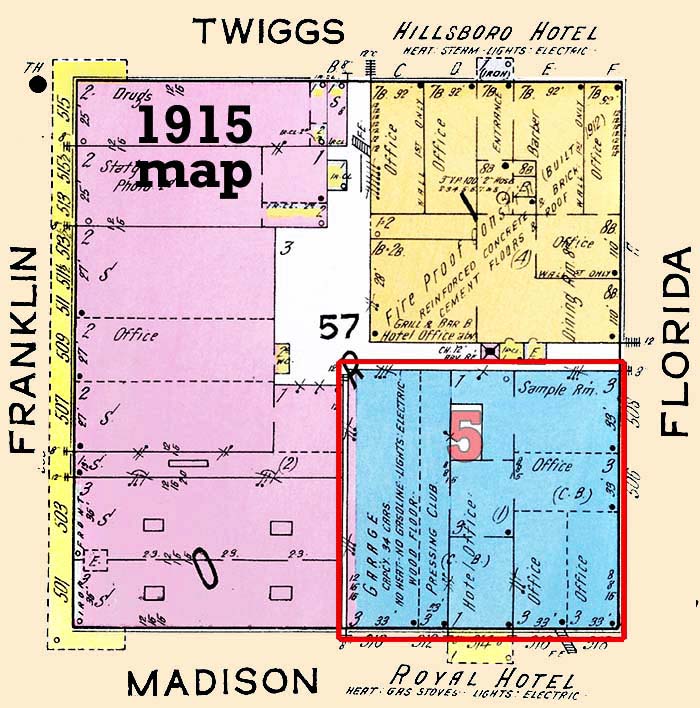
|
|
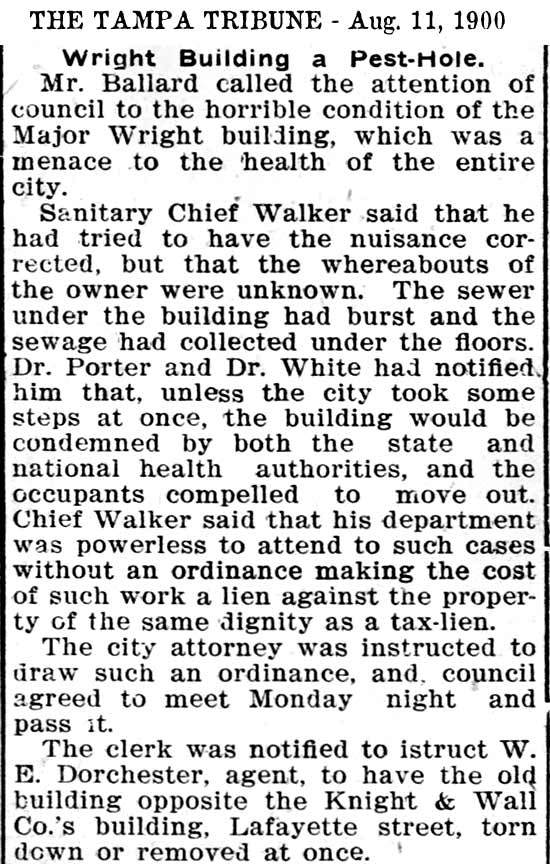
|
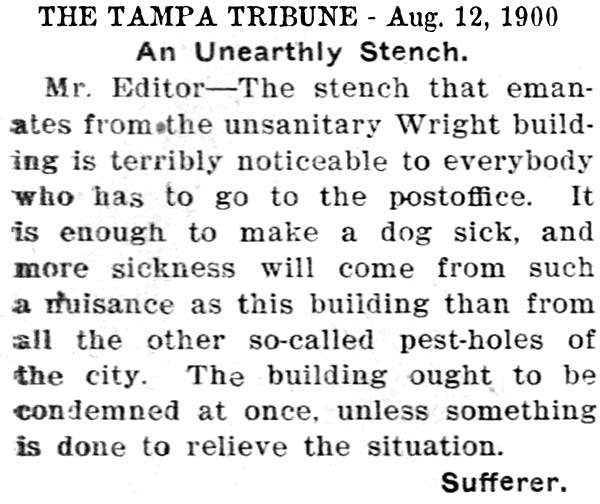
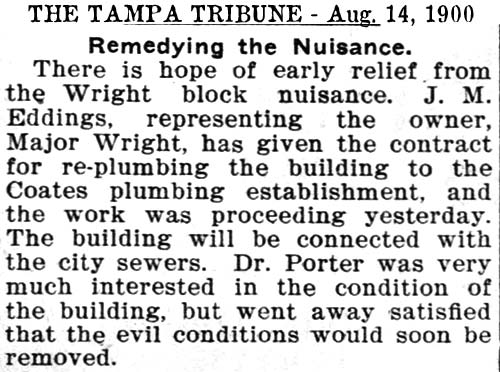 |
|
THE WRIGHT
BUILDING REBUILT |
|
In 1904 the Post
Office moved into the new Federal Building. Major Wright then
planned to remodel and "practically rebuild" the 2-story building to
convert it into a hotel
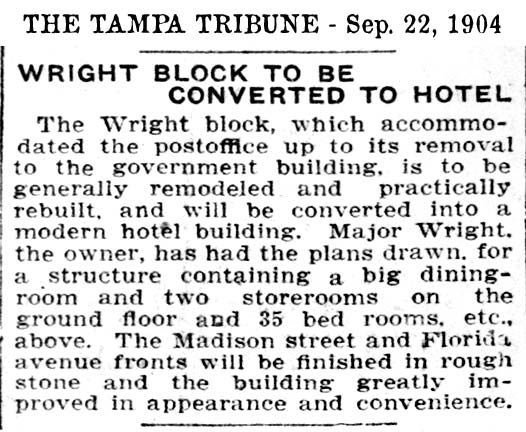
|
On Nov. 10, 1904,
the Tribune announced that work had begun on the Wright block under
the supervision of contractor J. M. Eddings.
The newly
refurbished, rebuilt Wright building had its first tenant moving in
by mid-May of 1905.
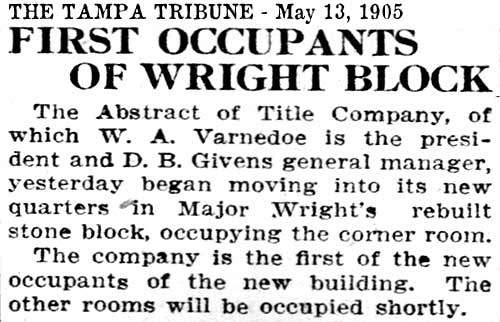
|
|
The new building was to have a
portion leased to businesses, and the rest serve as a hotel.
This article mentions "Large courts occupy the center of the
building, and the rooms open upon these as well as upon the street."
In October, J. L. Tallevast of Bradentown (now Bradenton) was
negotiating with Wright for the hotel lease.
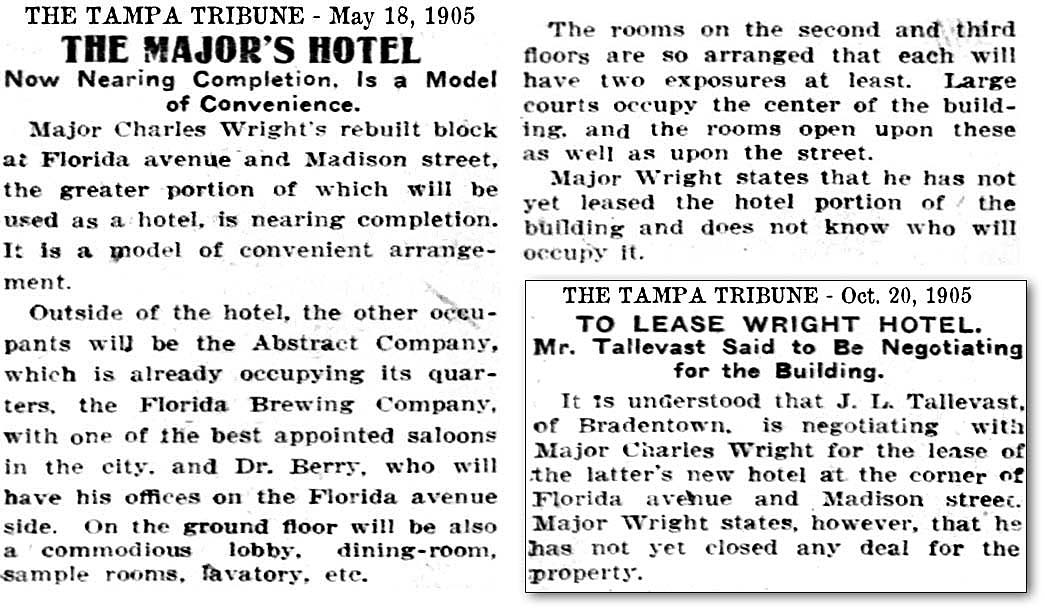
Major Wright named
his new hotel "The Hillsboro." It was leased by J. L.
Tallevast of Manatee Co. and opened on Nov. 14, 1905.
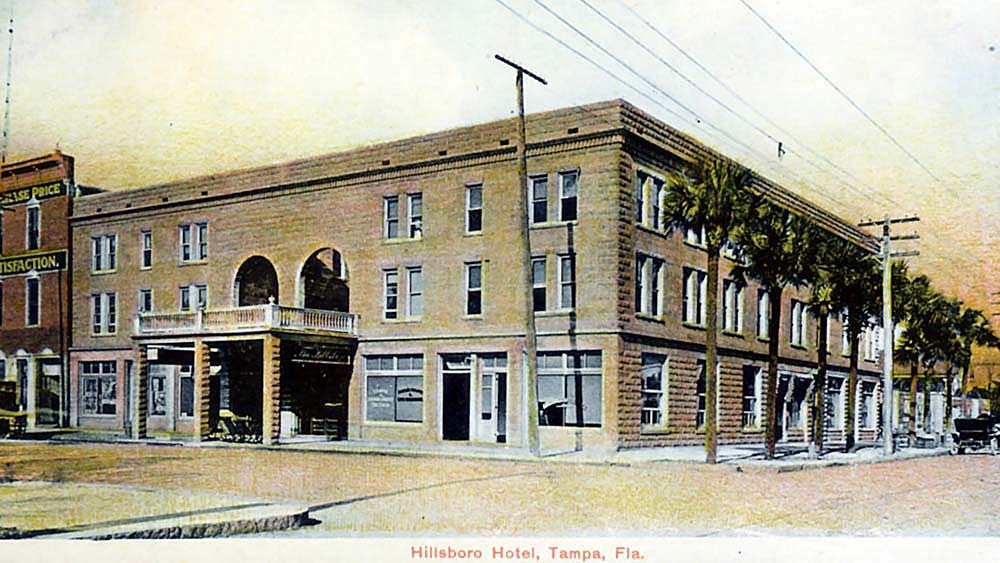
Major Wright's
first Hillsboro Hotel circa 1906 - 1911
Image courtesy of the University of South Florida
Hampton Dunn Collection of Florida Postcards
|
|
|
|
|
THE
NEW AND IMPROVED HILLSBORO HOTEL
In late
1911 to early 1912, Tallevast, along with his partners R. L. Hall of
Ocala, and L. B. Skinner of Dunedin, (The "Hillsboro Hotel Company")
the chief stockholders, began construction on an 8-story concrete,
steel and fireproof plaster hotel on the north side of the Royal, at
the southwest corner of Twiggs & Fla. Ave. It would measure
100 ft. square and "...have 108 guest rooms of the most modern
fashion, the Best in Dixie." The plans were to complete the
construction by early April, and soon demolish the old Hillsboro in
Maj. Wright's building and then build a twin structure, slightly
larger, to the new Hillsboro on that property, to join with it.
Construction ran behind schedule, and the hotel partially opened on
July 3, not completely finished, but with a "Handsome grill room" in
the basement, barber shop, pool room, telegraph office and 8th
floor dining room with a rooftop garden adjacent to it. The
guest rooms would not open until installation of telephones and the
switchboard was completed.
READ ALL
ABOUT IT - FULL ARTICLE ON THE OPENING
|
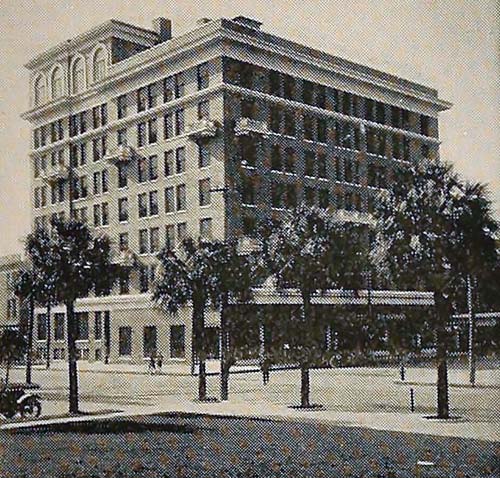
The original 8-story fireproof block Hillsboro Hotel, 1914.
Image from "Tampa
Today & Tomorrow" by the Tampa Board of Trade, at
Internet Archive. |
|
In Aug.
1912, Wright leased the old 3-story Hillsboro to George D.
Kronenberg of Tampa, who would renovate it and operate it "on the
European plan," under the name of the Hillsboro Hotel Annex, with 64
rooms, to be opened around Oct. 1. The west end, formerly a
cafe, was leased to Eugene Griffith who planned a movie/vaudeville
theater there opening by September. The plan was that in 19
months, the site would be demolished, and a twin hotel to the new
Hillsboro, but even larger, would be built on the property.
In late
Feb. of 1914, J. L. Tallevast awarded a contract to McGucken & Hyer,
to expand the new Hillsboro as planned. The design was being drawn
by architects Bonfoey & Elliott, but the construction had to wait
until April when the lease ran out on the old Hillsboro Hotel Annex,
which was then operating as the Royal Hotel.
|
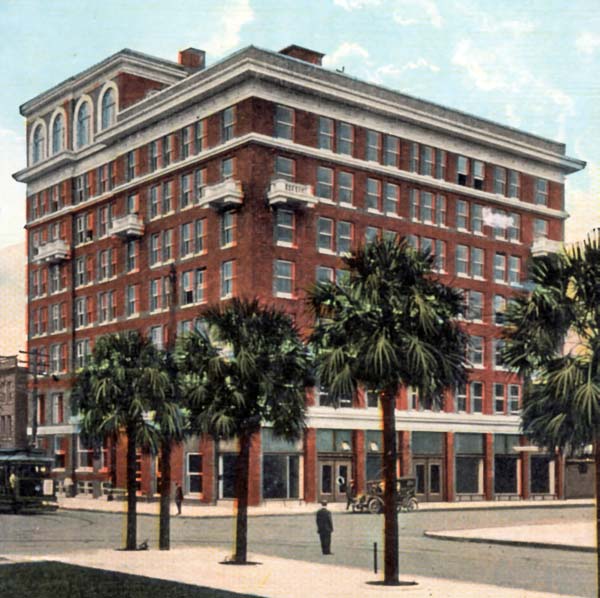
Circa 1914 postcard
courtesy of the Hampton Dunn postcard collection at the
University of S. Florida Library digital collections. |
|
TAMPA'S FIRST SKYSCRAPERS
Below is from
A History of the City of Tampa, etc, 1950,
by Karl Grismer, p.237-238.
Tampa's sky line was jabbed by skyscrapers for the first time in
1912 when the eight story, 320-room1
Hillsboro Hotel was completed and two ten-story giants were started,
one for Robert Mugge and the other for the Citizens Bank & Trust
Company, headed by John Trice.
The Hillsboro, then the largest commercial hotel in Florida, was
built by a company headed by Lee B. Skinner, a native of Wisconsin
who came to Florida in 1883, located at Dunedin , and made a fortune
in the citrus industry. The hotel was started late in 1911 and
opened in July, 1912. Associated with Skinner in the
project were "Major" Charles Wright, one of the best known men of
Tampa, and J. L. Tallevast, who had become wealthy dealing in naval
stores in Manatee County.
Wright had built
a two-story concrete block building on Madison just north of the
courthouse many years before. Cone's Livery Stable was located on
the ground floor and, in the late Nineties, the county had its first
high school overhead, on the second floor. The TAMPA TIMES also had
its home in the building at one time and so did the post office.2
The Hillsboro, situated just north of the Wright Building, filled a
long-felt need in Tampa. Prior to its erection, the principal hotel
open the year round was the DeSoto, built in 1892-93 by Capt. R. F.
Webb and Walter Parker. Designed by J. A. Wood, the architect who
had planned the Tampa Bay Hotel and the county courthouse, it was
topped by Moorish domes and minarets which Wood favored and was
adorned by rambling wooden porches and stately marble columns in the
lobby.3
However, the De Soto lacked modem bathroom facilities and the
Hillsboro became Tampa's leading hotel, immediately upon completion.
Later the De Soto was modernized and enlarged. Robert Mugge, builder
of one of the first ten-story skyscrapers Robert Mugge, was a large,
blond German who came to Tampa in 1884 and made a fortune in the
wholesale beer and liquor business.
[A paragraph on Mugge's achievements
has been omitted here.]
Mugge first planned his skyscraper for use as a warehouse. But
before it was completed he changed his mind and decided to turn it
into a hotel. On each floor there was a large, ornately decorated
lounge. Said Mugge "The way I've got it figured out, this
hotel is a cross between a YMCA and a ten-story bar room."
When opened the hotel was called the Bay View.
1
The Hillsboro Hotel
completed in 1912 was NOT a 320-room hotel. In 1912 the first phase
of the Hillsboro was completed with 124 guest rooms. Over the
years, this number has varied. When the 2nd phase was
completed in late December 1916, both phases of the conjoined hotel
in total boasted "250 rooms, an increase of 140 rooms" giving a room
count of 110 for the first phase.
2Grismer
has combined the history of two different buildings into one.
The Wright building that the Post Office, High School, Livery Stable
and Times printing office were in was a 2-story BRICK building.
Wright's concrete block building was 3 stories and replaced the brick
2-story Wright building in 1905. For about 9 years it operated
as the Hillsboro Hotel Annex, then for a short time as the Royal
Hotel.
3This
writer sees no evidence of the De Soto ever having domes or
minarets. The first one built of wood appears on Sanborn maps
starting in 1895.
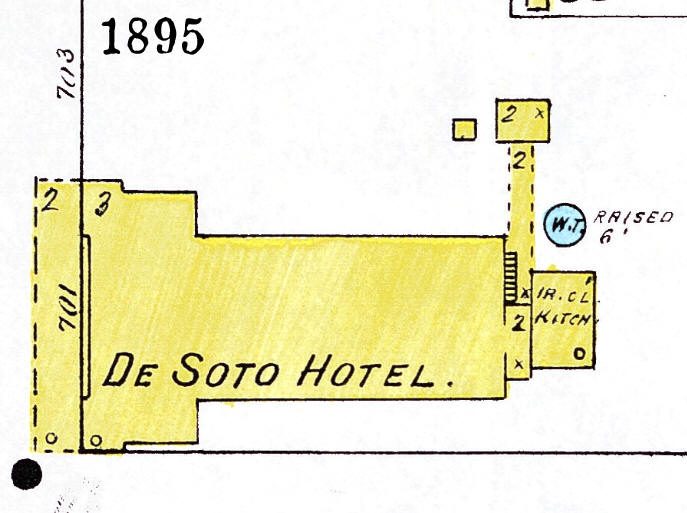
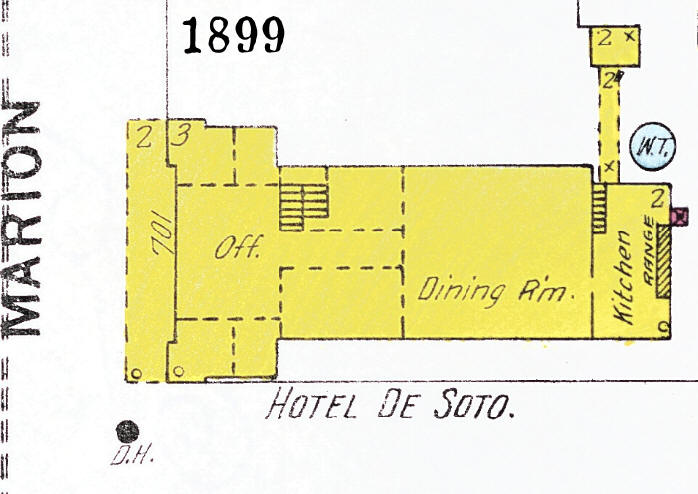
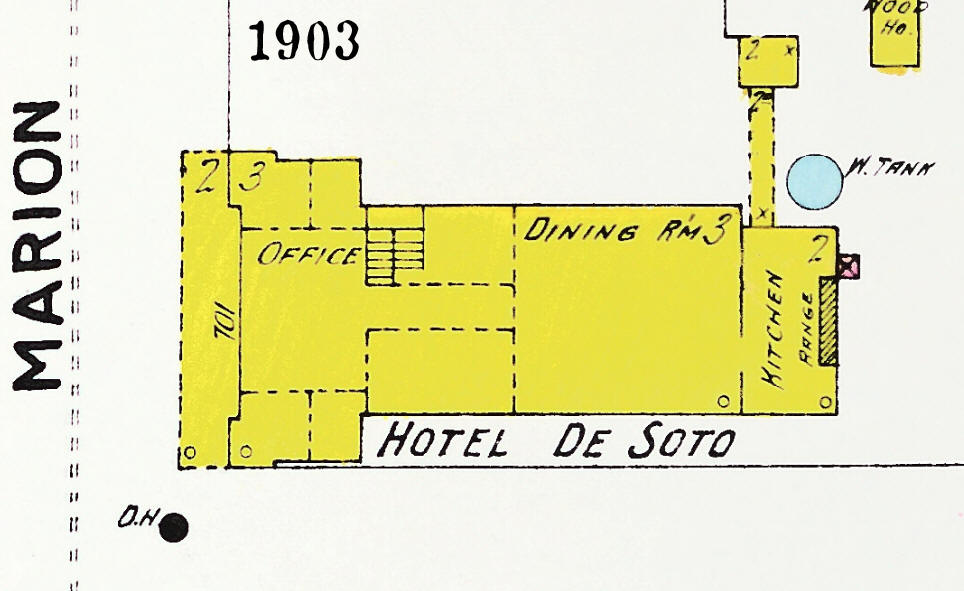
Sometime around 1910 the old wood frame De Soto was torn down and a
new one was built of brick Still no minarets or domes.
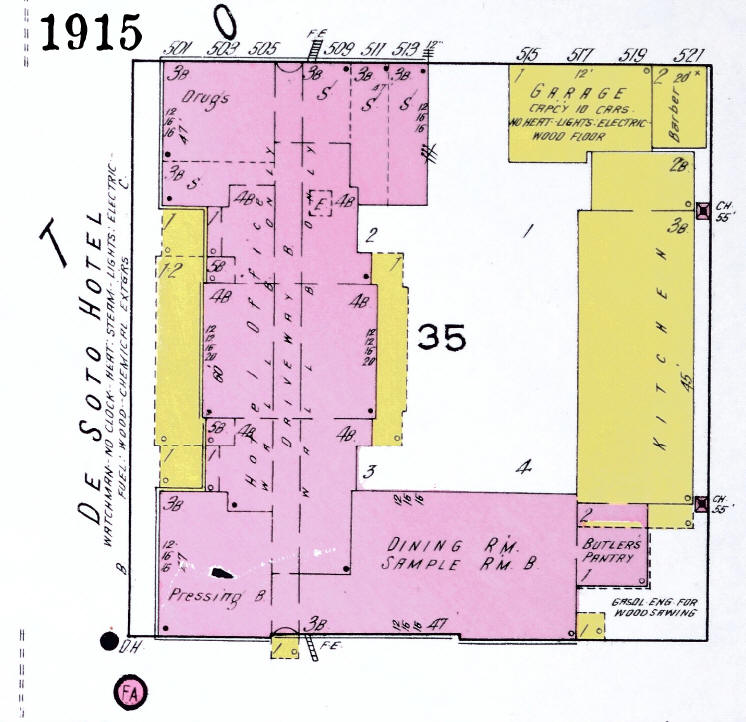
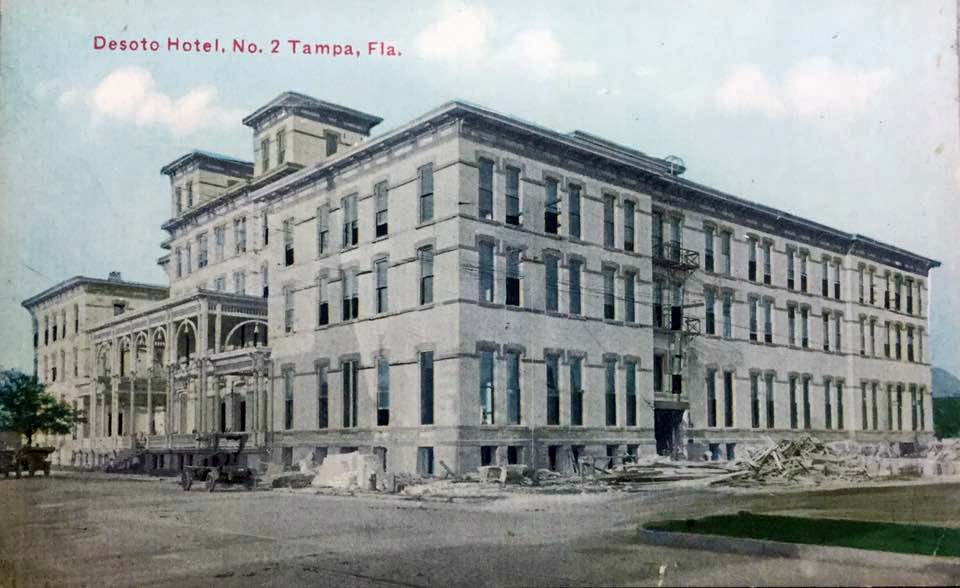
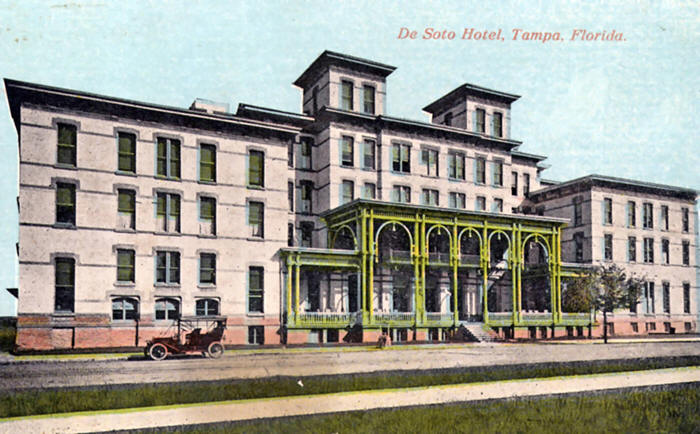
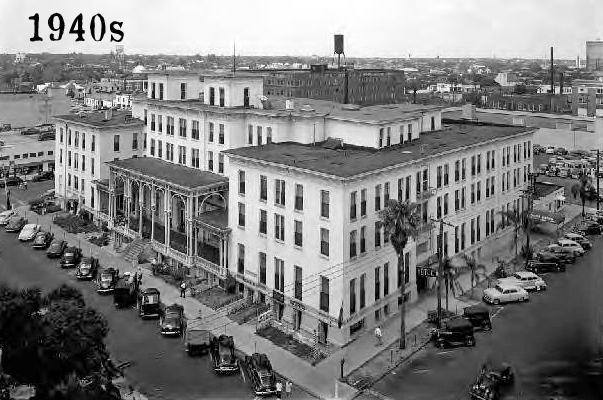
The DeSoto was demolished in 1955. No minarets
or domes were ever found. Maybe Grismer was thinking about the
old 1892 courthouse or the Tampa Bay Hotel. |
|
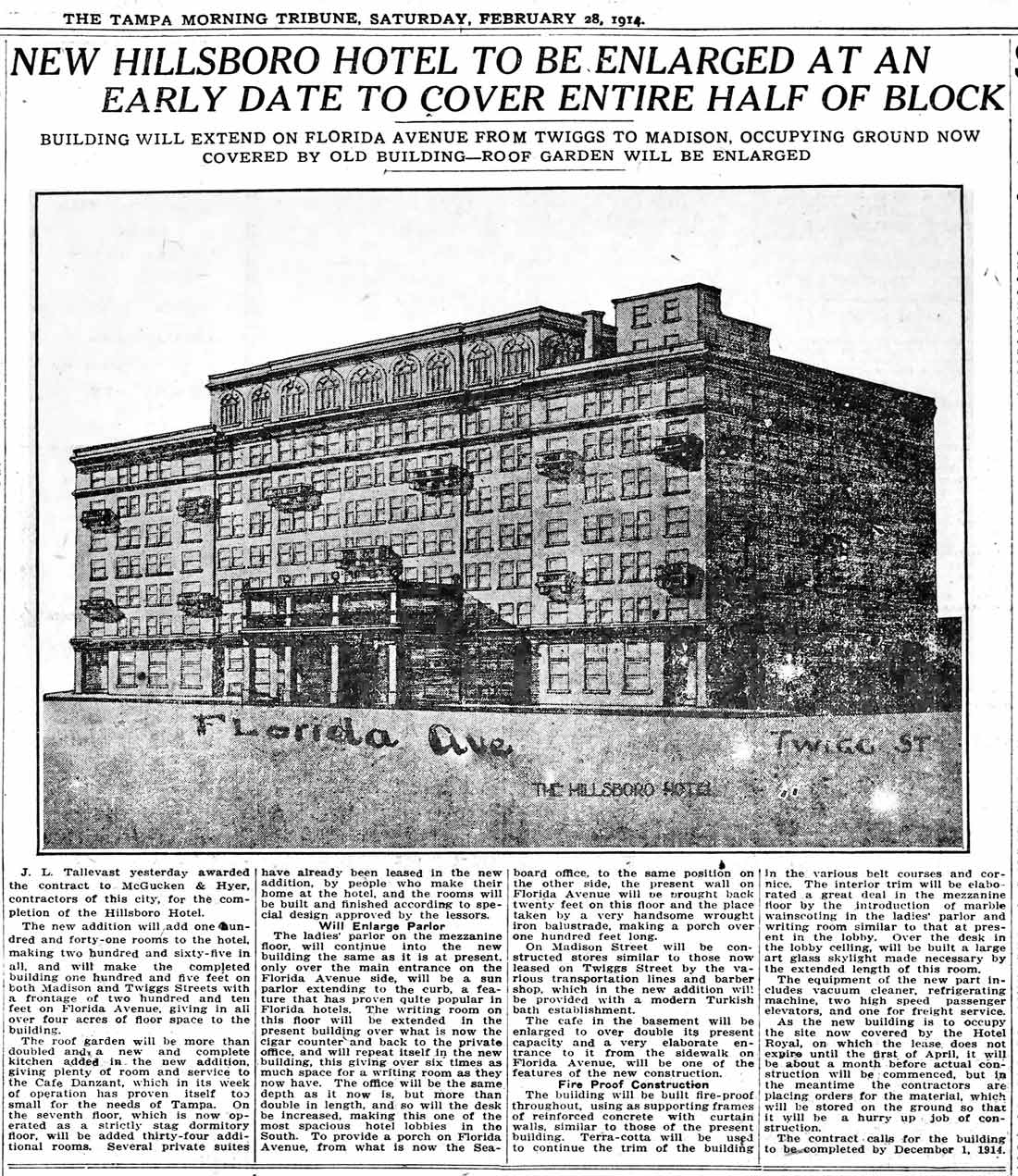 |
|
|
|
|
In
mid-April of 1914, Tallevast, entered into a deal with Wm. LeDuc to build a six to ten-story hotel on "the most valuable corner
in Tampa," Lafayette St. and Tampa Street. The property at the
time was occupied by a very popular restaurant, the Dairy Kitchen,
which had been operating there for 14 years. J. R. Mickler's
grocery store, and a barber shop were also situated on the property. Word was that Tallevast had given up plans for the Hillsboro Hotel addition for
this year, as some of the others in the Hillsboro company opposed
the expansion for this year, moving the plan to 1915.
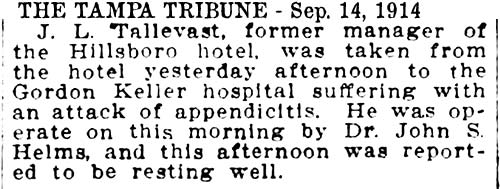 In late
April, 1914, Rich Hall of Ocala, who owned a large interest in
the Hillsboro, revealed that Tallevast had transferred his majority
stock interest to L. B. Skinner, making Skinner the majority
stockholder, and so the Hillsboro plans were put off until next year. Tallevast would neither confirm or deny the statement,
and placed a veil of secrecy on the Hillsboro plans. Hall was
quoted as saying, that if Tallevast continued with his plans with
LeDuc for the hotel at the Dairy Kitchen site, it is probable that
the Hillsboro directors would seek a new manager for the Hillsboro. In late
April, 1914, Rich Hall of Ocala, who owned a large interest in
the Hillsboro, revealed that Tallevast had transferred his majority
stock interest to L. B. Skinner, making Skinner the majority
stockholder, and so the Hillsboro plans were put off until next year. Tallevast would neither confirm or deny the statement,
and placed a veil of secrecy on the Hillsboro plans. Hall was
quoted as saying, that if Tallevast continued with his plans with
LeDuc for the hotel at the Dairy Kitchen site, it is probable that
the Hillsboro directors would seek a new manager for the Hillsboro.
Eventually, in 1916, the Hillsboro Hotel was expanded, taking over
the Royal Hotel and the whole block on the west side of
Florida Ave. Construction was essentially finished on
Dec. 10, 1916.
More
on this period will be added later.

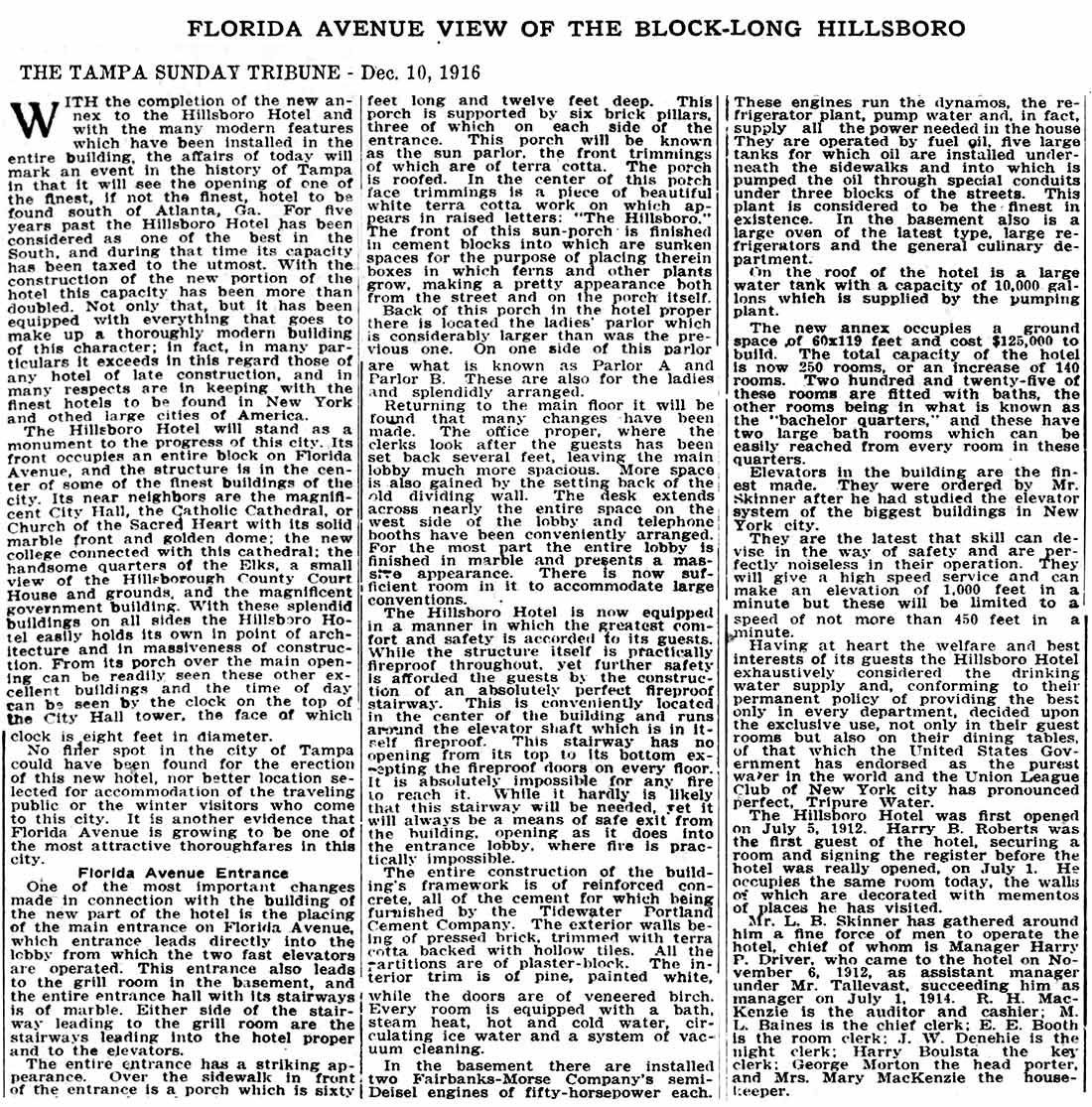
|
|
If
you arrived here from a search, go to the History of Hillsboro High
school
click here.
Otherwise, just close this window. |
|